warning light AUDI S8 2016 Manual PDF
[x] Cancel search | Manufacturer: AUDI, Model Year: 2016, Model line: S8, Model: AUDI S8 2016Pages: 302, PDF Size: 75.68 MB
Page 157 of 302
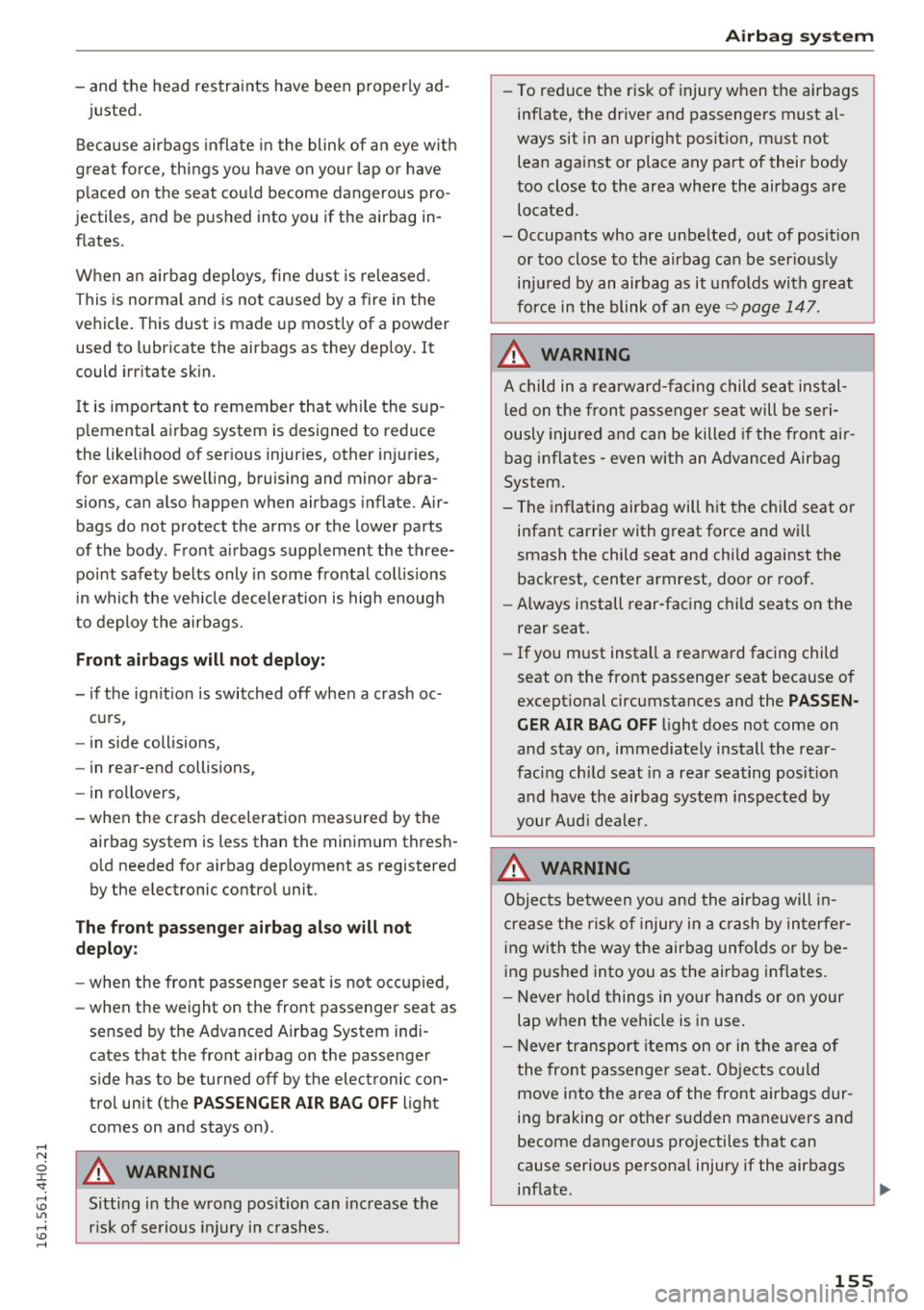
-and the head restraints have been properly ad -
justed.
Because airbags inflate in the blink of a n eye w ith
great for ce, things you have on you r lap or have
p laced on the seat cou ld become dangerous pro
jectiles, and be pushed into you if the airbag in
flates.
When an a irbag deploys, fine dust is released .
This is normal and is not caused by a fire in the
vehicle. This dust is made up mostly of a powder
used to lubricate the airbags as they deploy. It
could irr itate skin.
It is important to remember that while the sup
p lemental airbag system is designed to reduce
the likelihood of ser ious injuries, other inj uries,
for example swell ing, bruising and minor abra
sions, can also happen when airbags inflate. Air
bags do not protect the arms or the lower parts
of the body . Front airbags supplement the three
point safety belts only in some frontal collisions
i n which the veh icle decelerat ion is high enough
to deploy the airbags.
F ront airbags will not deploy:
- if the ignit ion is switched off when a crash oc -
curs,
- in s ide collisions,
- in rear-end collisions,
- in rollovers,
- when the crash decelerat ion measured by the
airbag system is less than the minimum thresh
o ld needed for airbag deployment as registered
by the electronic contro l unit .
Th e front passeng er airbag also will not
deplo y:
- when the front passenger seat is not occupied,
- when the weight on the front passenger seat as
sensed by the Advanced Airbag System indi
cates that the front airbag on the passenger
s ide has to be turned off by the electronic con
trol unit (the
P A SSENGER AIR B AG OFF light
comes on and stays on).
A WARNING
Sitting in the wrong pos ition can increase the
r isk of se rious injury in c rashes.
Airb ag sys tem
-To reduce the risk of injury when the ai rbags
inflate, the driver and passengers must al
ways sit in an upright posit ion, must not
lean aga inst or place any part of their body
too close to the area where the airbags are located.
- Occupants who are unbelted, out of posit ion
or too close to the airbag can be seriously in jur ed by an airbag as it unfolds with g reat
for ce in the blink of an eye
Q page 147.
A WARNING
A child in a rearward-facing child seat instal
l ed on the front passenger seat will be se ri
ously injured and can be killed if the front air
bag inflates - even with an Advanced Airbag
System .
- The inflating airbag will hit the child seat or infant carrier with great force and will
smash the child seat and child against the backrest, center armrest, door or roof.
- Always install rear-fac ing child seats on the
rear seat.
- If you must install a rea rward facing child
seat on the front passenger seat because of
except ional circumstances and the
PASSEN
GER AIR BAG OFF
light does not come on
and stay on, immed iate ly install the rear
faci ng chi ld seat in a rear seating posit ion
and have the airbag system inspected by
your Aud i dea le r.
A WARNING
-
-
Objects between yo u and the airbag will in
crease the risk of injury in a crash by interfer i ng with the way the airbag unfolds or by be
ing pushed into you as the airbag inflates .
- Never hold things in yo ur hands or on your
lap when the veh icle is in use .
- Never transport items on or in the a rea of
the front passenger seat . Obje cts could
move into the a rea of the front airbags dur
ing b raking or other s udden maneuvers and
become dangerous projectiles that can
cause serious persona l injury if the airbags
inflate.
155
Page 158 of 302
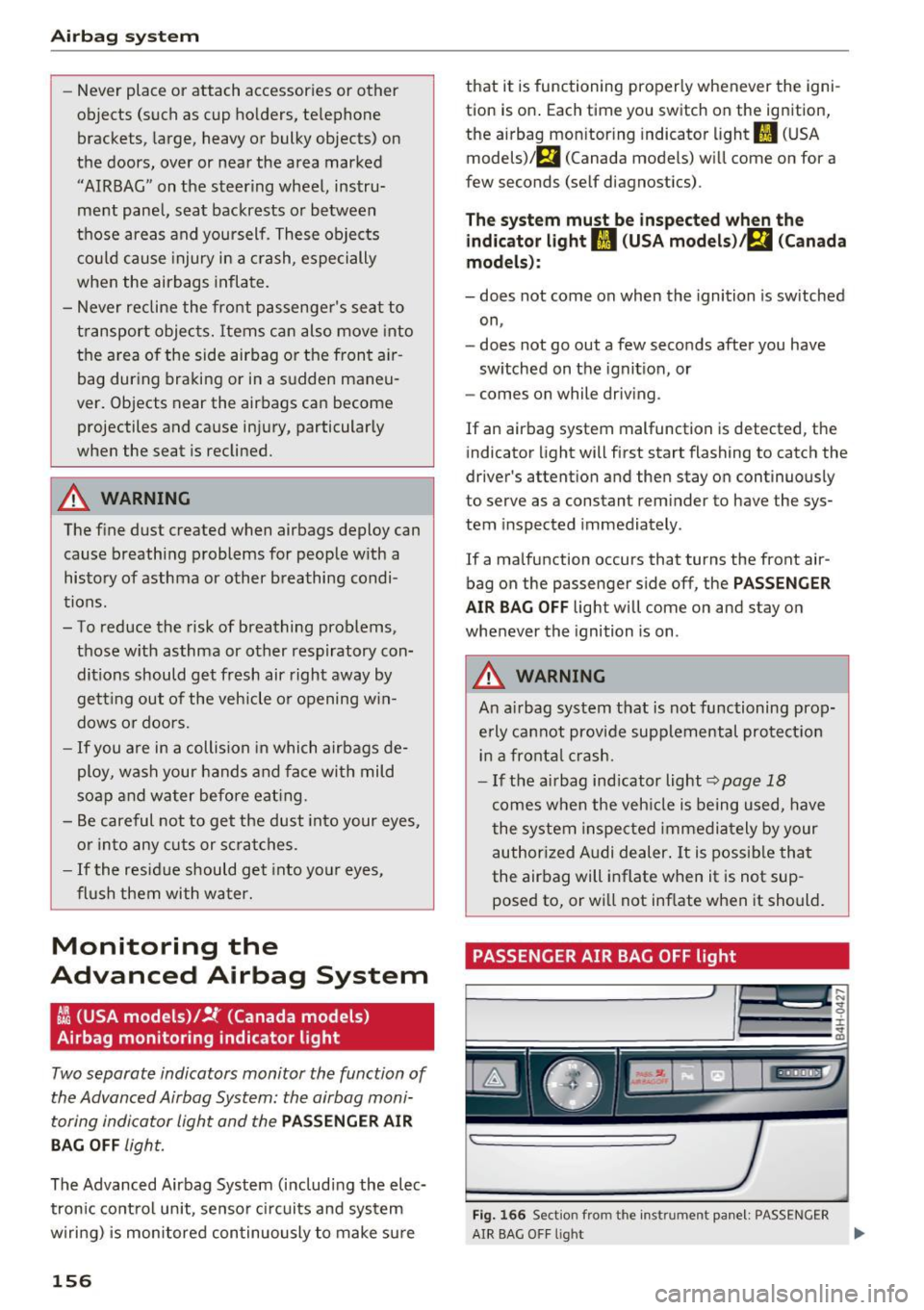
Airbag syste m
-Never place or attach accessories or other
objects (such as cup ho lders, te lephone
brackets, large, heavy or bulky objects) on
the doors, over or near the area marked "AIRBAG" on the steering wheel, instru
ment pane l, seat backrests or between
those areas and yourself. These objects
could cause injury in a crash, especially
when the airbags inflate.
- Never recline the front passenger's seat to
transport objec ts. Items can also move into
the area of the side airbag or the front a ir
bag dur ing braking or in a sudden maneu
ver. Objects near the airbags can become projectiles and cause injury, particularly
when the seat is reclined.
A WARNING
The fine dust created when airbags deploy can
cause breath ing problems for people w ith a
history of asthma or other breathing condi
t ions.
- To reduce the risk of breathing problems,
those w ith asthma or other respiratory con
ditions should get fresh air right away by
gett ing out of the vehicle o r opening w in
dows o r doors.
- If you are in a collision in which airbags de
ploy, wash your hands and fa ce with mild
soap and water befo re eat ing.
- Be careful not to get the dust into your eyes,
o r into any cu ts or sc ratches.
- If the resid ue should get into yo ur eyes,
flush them with water.
Monitoring the
Advanced Airbag System
~i (USA models)/!f (Canada models)
Airbag monitoring indicator light
Two separate indicators monitor the function of
the Advanced Airbag System: the airbag moni
toring indicator light and the
PASSENGER AIR
BAG OFF
light.
The Advanced Airbag System (including the elec
tron ic co ntrol unit, senso r ci rcui ts and system
w iri ng) is monitored con tinuously to make su re
156
that it is functioning properly whenever the igni
tion is on. Each time you switch on the ignition,
the airbag mon itor ing indicator light
rl (U SA
models)/ E,I (Canada models) will come on for a
few seconds (se lf diagnostics) .
The system mu st be inspected wh en th e
indicat or light
II (USA models) /m (Canada
models ):
- does not come on when the ignition is sw itched
on,
- does not go out a few seconds after you have
sw itched on the ignit ion, or
- comes on while driving.
If an airbag system malfunction is detected, the
indicator light will first start flashing to catch the
driver's attention and then stay on continuously
to serve as a constant reminder to have the sys
tem inspected immediately .
If a malfunction occurs that turns the front air
bag on the passenger side off, the
PASSENGER
AIR BAG OFF
light will come on and stay on
whenever the ignition is on .
A WARNING
An airbag system that is not functioning prop
e rly cannot provide supplemental protectio n
i n a fronta l crash.
- If the ai rbag ind icator light
Q page 18
comes when the veh icle is being used, have
t he system inspected immedia tely by your
author ized Audi dealer . It is possi ble that
the airbag will inflate when it is not sup
posed to, or will not inflate when it should .
PASSENGER AIR BAG OFF light
Fig. 16 6 Sect ion from the instrument panel: PASSENGER
AIR BAG O FF light .,,_
Page 160 of 302
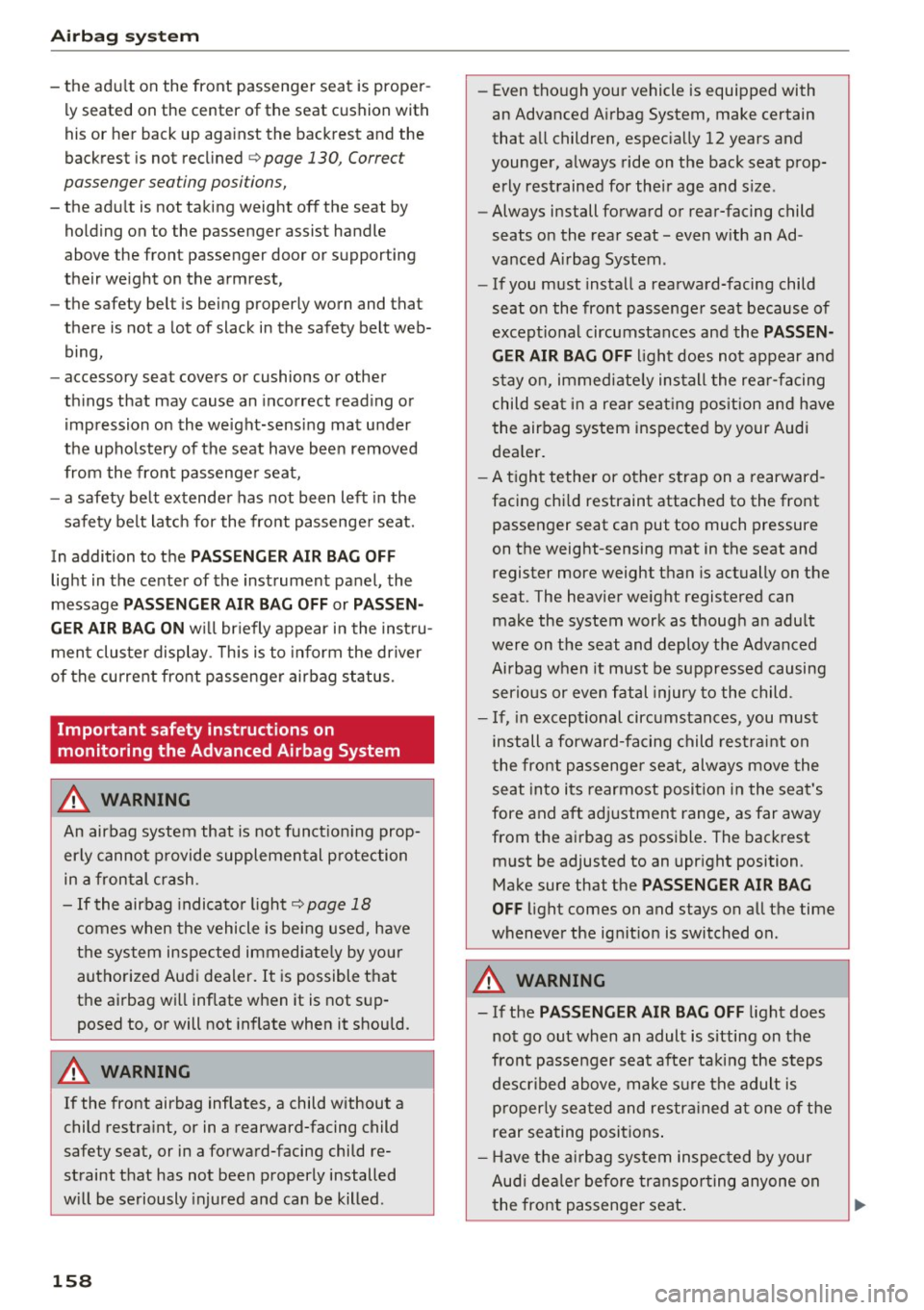
Airbag syste m
-the adu lt on the front passenger seat is proper
ly seated on the center of the seat cushion with
his or her back up against the backrest and the
backrest is not reclined
c> page 130, Correc t
passenger seating positions,
- the adu lt is not taking weight off the seat by
holding on to the passenger assist handle
above the fron t passenger door or supporting
their we ight on the armrest,
- the safety bel t is being properly worn and that
there is not a lot of slack in the safety belt web
bing,
- accessory seat covers or cushions or other
th ings that may cause an incorrect read ing or
impression on the weight-sensing mat under
the upho lstery of the seat have been removed
from the front passenge r seat,
- a safety be lt extender has not been left in the
safety belt latc h for the front passenge r seat.
In addition to the
PA SSE NGER AIR BAG OFF
light in the center of the instrument panel, the
message
PASSENGER AIR BAG OFF or PASSEN
GER AIR BAG ON
w ill briefly appear in the inst ru
ment cluster display . T his is to inform the driver
of the current front passenger airbag status.
Important safety instructions on
monitoring the Advanced Airbag System
A WARNING
An airbag system that is not funct ion ing prop
er ly cannot p rovide supplemental p rotection
in a frontal crash .
- If the airbag indicato r light
r=>page 18
comes when the vehicle is be ing used, h ave
the system inspected immediate ly by yo ur
authorized Aud i dealer . It is possible that
the airbag will inflate when it is not s up
posed to, or will not inflate when it should.
A WARNING
If the front airbag inflates, a child without a
child restraint, or in a rearward-facing child
safety seat, or in a forward-facing child re
straint that has not been properly installed
w ill be seriously injured and can be killed .
158
-Even tho ugh your vehicle is equipped with
an Advanced A irbag System, make certain
that a ll children, espec ia lly 12 years and
younger, always ride on the back seat prop
erly restrained for their age and s ize.
- Always install forward or rear-facing child
seats on the rear seat -even w ith an Ad
vanced Airbag System .
- If you must install a rearward-facing child
seat o n the front passenge r seat because of
except ional circumstances and the
PASSEN
GER AIR BAG OFF
light does not appear and
s tay on, immediate ly ins tall the re ar-fa cing
child sea t in a rear seat ing pos ition and have
the airbag system inspected by your Audi
dea ler.
- A t ight tether or other s trap on a rearward
facing chi ld restraint attached to the front
passenger seat can put too much pressure
on the weight-sensing mat in the seat and
register more weight than is actually on the
seat . The heavier weight registered can
make the system work as thoug h an adu lt
were on the seat and deploy the Advanced
Airbag when it must be suppressed causing
serious or even f atal injury to the child .
- If, in exceptional circumstances, you must
install a forward-fa cing child res traint on
the front p assenge r seat, always move the
seat into i ts rearmost posi tion in the sea t's
fore and aft ad justment range, as far away
from the ai rbag as possible . The back rest
must be adjusted to an upr ight position .
Make sure that the
PASSENGER AIR BAG
OFF
li ght comes on and stays on all the time
wheneve r the ignit ion is switched on.
A WARNING
- If the PASSENGER AIR BAG OFF light does
not go out when an adult is sitting on the
front passenger seat afte r taking the steps
described above, make s ure the adult is
p roper ly sea ted and restra ined at one o f the
rear sea ting posit ions .
- Have the ai rbag system inspec ted by your
Aud i dea le r before tr anspor ting anyone on
the front passenge r seat .
Page 161 of 302
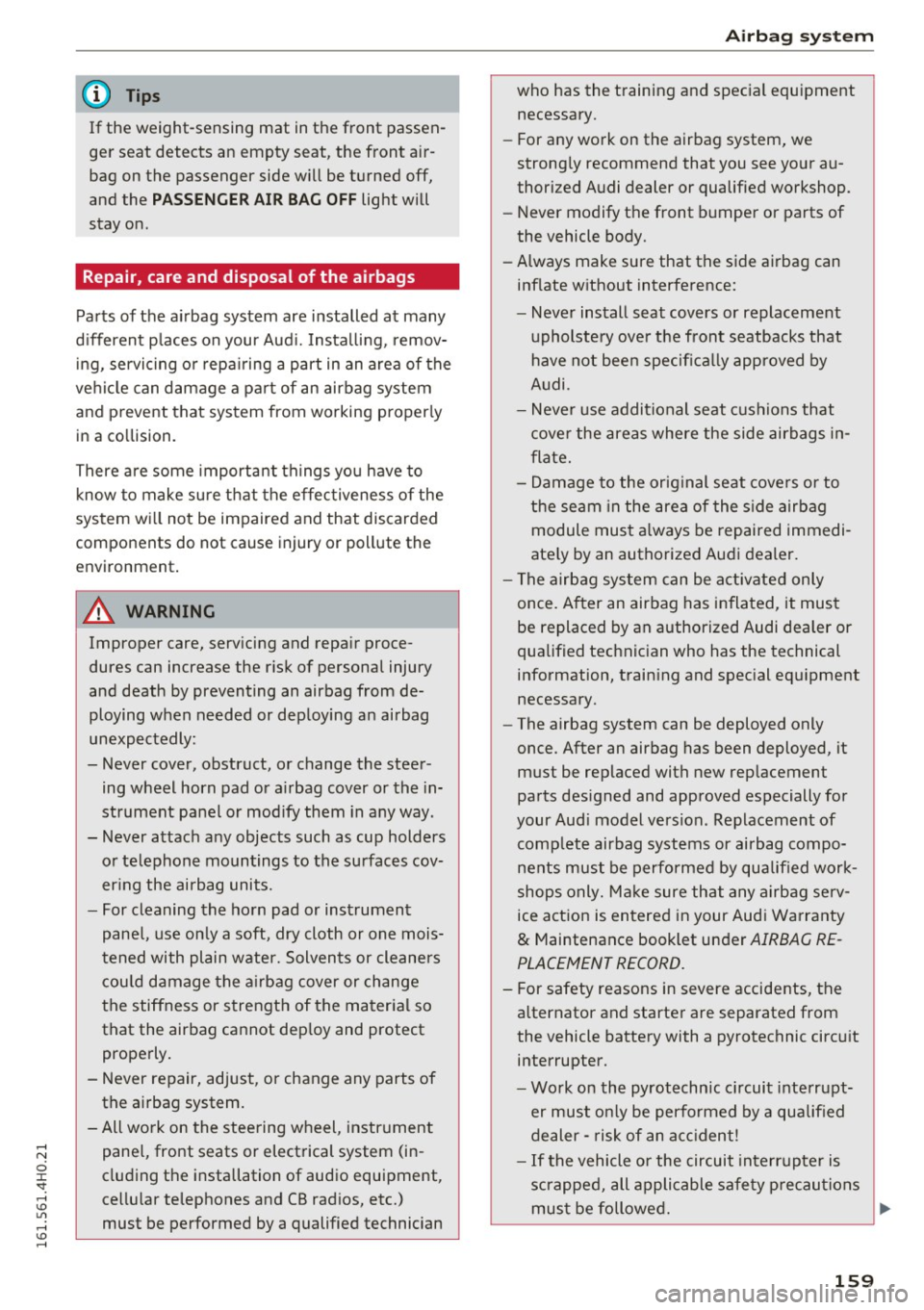
(D Tips
If the weight-sensing mat in the front passen
ger seat detects an empty seat, the front air
bag on the passenger side will be turned off,
and the
P ASS ENGER AI R BA G OFF light will
stay on.
Repair , care and disposal of the airbags
Parts of the a irbag system are installed at many
d ifferent p laces on your Aud i. Installing , remov
ing, servic ing or repa iring a part in an area of the
vehicle can damage a part of an airbag system
and p revent that system from working properly
in a co llision.
There are some important things you have to
know to make su re that the effectiveness of the
system w ill not be impaired and that discarded
components do not cause injury or pollute the
environm ent .
A WARNING
Improper care, serv icing and repa ir proce
dures can increase the risk of personal injury
and death by preventing an airbag from de
ploying when needed or deploying an airbag
unexpectedly:
-
- Never cover, obstruct, or change the steer
ing wheel horn pad or a irbag cover or the in
strument panel or mod ify them in any way .
- Never attach any objects such as cup holders or telephone mountings to the surfaces cov
er ing the airbag units.
- For cleaning the horn pad or instrument
pane l, use on ly a soft, dry cloth or one mois
tened with plain water. Solvents or cleaners cou ld damage the a irbag cover or change
the stiffness or strength of the material so
that the airbag cannot dep loy and protect
properly.
- Never repair, adjust, or change any parts of
the airbag system.
- All work on the steering wheel, instr ument
pane l, front seats or electrical system (in
cluding the installation of audio equipment,
cellu lar telephones and CB radios, etc.)
must be performed by a qualified technician
Airb ag sys tem
who has the training and special equ ipment
necessary.
- For any wo rk on the airbag system, we
strong ly recommend that you see your au
thorized Audi dealer or qualified workshop .
- Never modify the front bumper or parts of
the vehicle body.
- Always make sure that the side a irbag can
inflate without interference:
- Never install seat covers or replacement
upholstery ove r the front seatbacks that
have not been specifica lly approved by
Audi .
- Never use addi tional seat c ushions that
cove r the areas where the side airbags in
flate.
- Damage to the orig inal seat cove rs or to
the seam in the area of the s ide airbag
module must a lways be repaired immedi
ate ly by an authorized Aud i dealer.
- The airbag system can be activated only
once . A fter an airbag has inflated, it must
be replaced by an authorized Audi dealer or
qualified technic ian who has the technical
information, t raining and spec ial equ ipment
necessary.
- The airbag system can be deployed only
once . After an airbag has been deployed, it
must be replaced with new rep lacement
parts des igned and approved especially for
your Aud i model version. Replacement of
comp lete airbag systems or airbag compo
nents must be performed by qualified work
shops only. Ma ke sure that any airbag serv
ice act ion is en tered in your Aud i Wa rranty
& Maintenance booklet under AIRBAG RE
PLACEMENT RECORD.
- For safety reasons in severe accidents, the
alternator and starter are separated from
the vehicle battery with a pyrotechnic circ uit
interrupter.
- Wo rk on the pyrotechnic c ircuit inte rrupt
er must on ly be performed by a qua lified
dealer -risk of an acc ident!
- If the vehicle or the circuit interr upter is
scrapped, all applicable safe ty p recau tions
mus t be followed.
159
Page 163 of 302
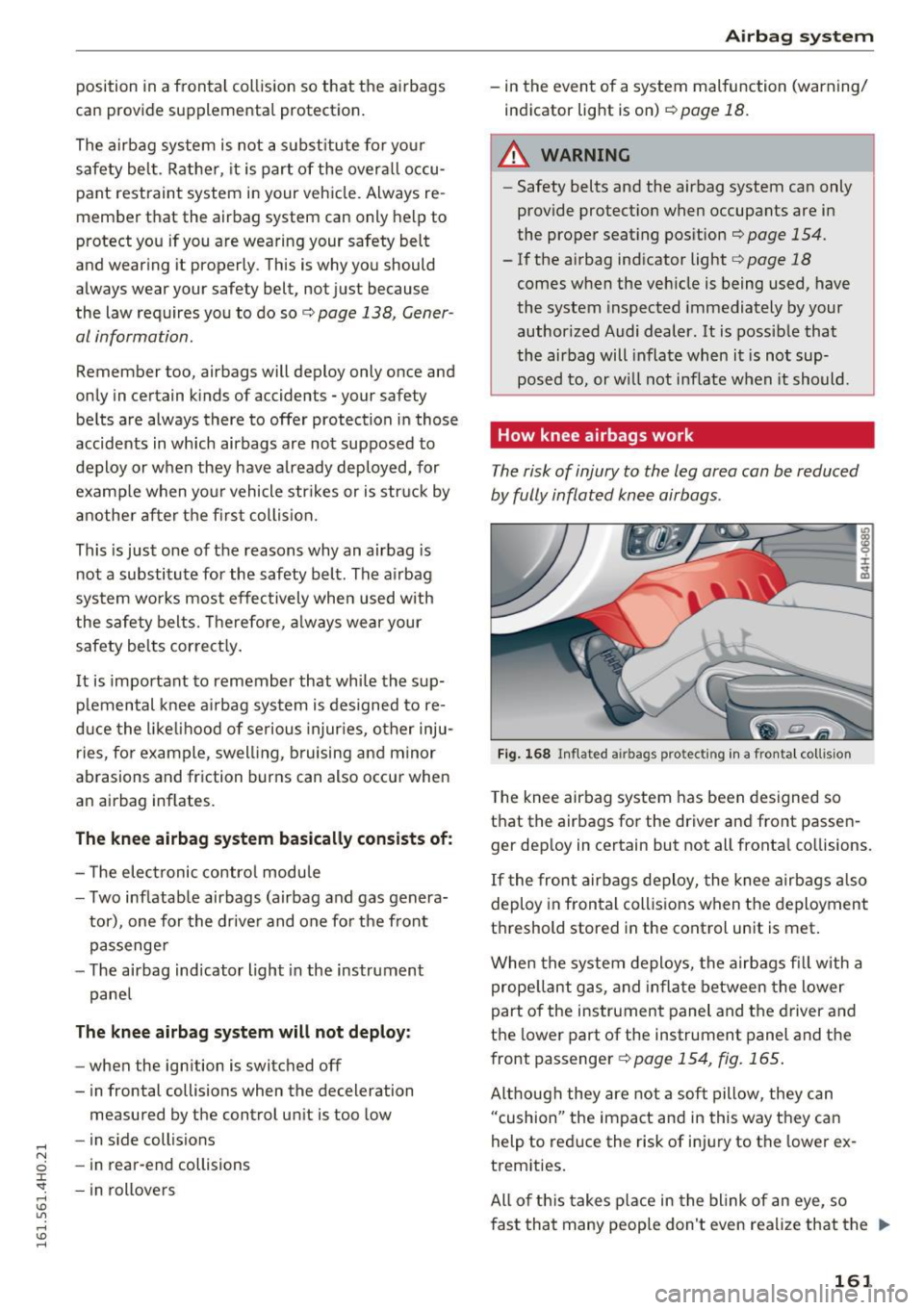
position in a frontal collision so that the airbags
can provide supplemental protection.
The airbag system is not a s ubst itute for yo ur
safety belt. Rather, it is part of the overa ll occu
pant restraint system in your vehicle. Always re
member that the airbag system can only help to
protect you if you are wearing your safety belt
and wear ing it properly . This is why you should
always wear your safety belt, not just because
the law requires you to do soc::,
page 138, Gener
al information.
Remember too, airbags will deploy only once and
only in certain k inds of accidents -your safety
be lts
a re always there to offer protection in those
accidents in which airbags are not supposed to
deploy or when they have a lready dep loyed, for
examp le when yo ur vehicle str ikes or is str uck by
anothe r afte r the f irst collis ion.
This is just one of the reasons why an airbag is
not a substitute for the safety belt. The a irbag
sys tem wo rks most effec tively when used with
the safety belts. Therefore , al ways wear your
safety bel ts cor rect ly .
It is important to remember that while the sup
p lemental knee a irbag sys tem is designed to re
d uce the like lihood of serious injur ies, other inju
ries, fo r example, swell ing, b ruising and minor
abrasions and fr iction burns can also occu r when
an airbag inflates.
The kne e airbag system basically consists of:
- The electronic contro l modu le
- Two inf latab le airbags (airbag and gas genera-
tor), one for the dr ive r and one fo r the front
passenge r
- T he airbag ind icator light in the instrument
pane l
The knee airbag system will not deploy:
-when the ignition is switched off
- in frontal collisions when the deceleration
measured by the control unit is too low
- in side collisions
- in rear-end collisions
- in rollovers
Airb ag sys tem
-in the event of a system malfunction (warning/
indicator light is on)
c::, poge 18.
.&_ WARNING
-
-Safety belts and the airbag system can only
provide protect ion when occupants are in
the proper seat ing pos ition
c::,page 154.
-If the airbag indicator light c::, page 18
comes w hen the veh icle is being used, have
the system inspected immediately by your
author ized Audi dealer. It is possible that
the airbag will inflate when it is not sup
posed to, or w ill not inflate w hen it should.
How knee airbags work
The risk of injury to the leg area can be reduced
by fully inflated knee airbags .
Fig . 1 68 Inflated a irbags pro tecting in a frontal co llision
T he knee air bag system has been designed so
that the airbags for the driver and front passen
ger dep loy in certain but not all fronta l co llisions.
If the front airbags deploy, the knee a irbags a lso
deploy in frontal coll is ions when the deployment
t h reshold stored in the control unit is met .
When the system deploys, the a irbags fi ll w ith a
prope llant gas, and infla te between the lower
part of the instrument panel and t he driver and
the lower part of the instrument panel and the
f ront passenger
c::, page 154, fig. 165 .
Although they are not a soft pillow, they can
"cushion" the impact an d in this way they can
help to red uce the risk of inj ury to the lower ex
tremities.
All o f th is takes place in the blink of an eye, so
f ast that many peop le don't even realize that the .,..
161
Page 165 of 302
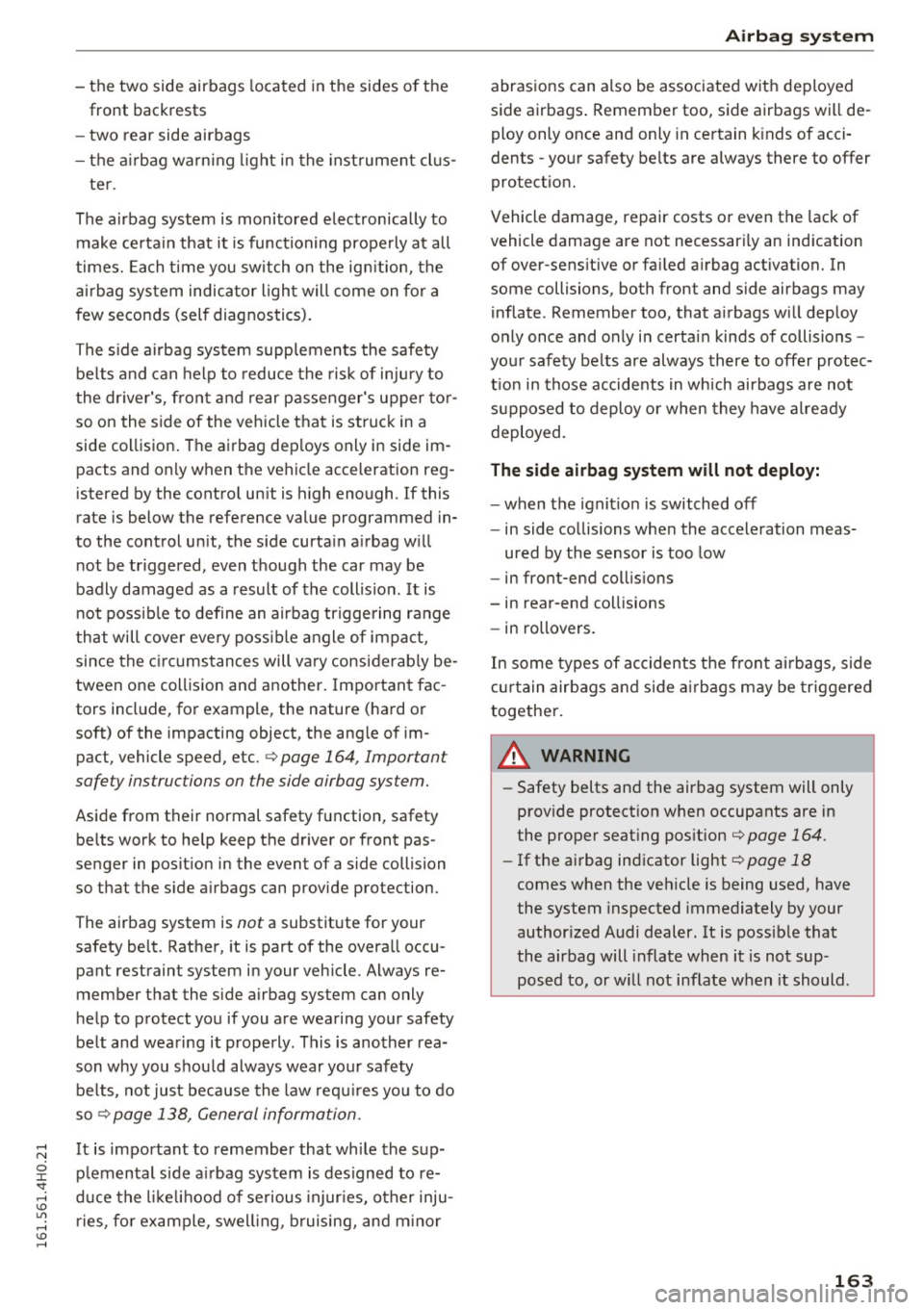
-the two side airbags located in the sides of the
front backrests
- two rear side airbags
- the a irbag warning light in the inst rument clus-
te r.
The airbag system is monitored electronically to make certain that it is functioning properly at all
times. Each time you sw itch on the ign it ion, the
a ir bag sys tem indicator light will come on for a
few seconds (self diagnostics).
The s ide a irbag system supp lements the safety
be lts and can he lp to reduce the risk of injury to
the dr iver's, front and rear p assenger's upper to r
so on the side of the vehicle that is struck in a
side col lision . The airbag dep loys only in side im
pacts and on ly when the vehicle acceleration reg
istered by the control un it is h igh enough. If this
rate is below the reference value programmed in
to the control un it, the s ide curta in a irbag w ill
not be triggered, even though the car may be
badly damaged as a result of the collision.
It is
n ot possib le to define an airbag triggering range
that will cover eve ry poss ible angle of impa ct,
since the c ircums tances will vary considerab ly be
tween one collision and a nother. Impo rtant fac
tors incl ude, fo r example, the nature (hard or
soft) of the impacting object, the ang le of im
pact, vehicle speed, etc .
c> page 164, Important
safety instructions on the side airbag system.
Aside from their normal safety function, safety
be lts work to he lp keep the driver or front pas
senger in position in the event of a side collision
so that the s ide a irbags can provide protection.
The airbag system is
not a substitute for your
safety belt. Rather, it is part of the overa ll occu
pant restraint system in your veh icle. Always re
member that the s ide airbag system can only
help to protect you if you are wearing your safety
belt and wea ring it properly . This is another rea
son why you shou ld always wear your safety
be lts, not just because the law requ ires yo u to do
so
c> page 138, General information.
It is important to remember that wh ile the sup
p lemental side a irbag system is designed to re
duce the likeli hood of serious injur ies, other inju
ries, fo r example, swell ing, b ruising, and m inor
Airb ag sys tem
abras ions can also be assoc iated wit h deployed
side airbags . Remember too, side airbags will de
ploy only once and only in ce rtain k inds of acci
dents - yo ur safety belts are always there to offer
protect ion.
Vehicle damage, repair costs or even the lack of
vehicle damage are not necessar ily an ind ication
of over-sens it ive or fa iled a irbag activation. In
some collisions, both front and side airbags may
i nflate . Remember too, that a irbags w il l deploy
only once and only i n certai n kinds of collisions -
you r safety belts are always there to offer protec
t io n in those accide nts in wh ich airbags are no t
s u pposed to deploy o r when they h ave al re ady
deployed.
The side airbag system will not deploy:
- when t he ignit io n is switched off
- in side co llisions whe n the acceleration meas-
ured by the sensor is too low
- in front-end collis ions
- in rear -end co llisions
- in rollovers.
In some types of accidents t he front a irbags, s ide
c urt ain airbags and side airbags may be triggered
togethe r.
.&, WARNING ~
- Safety belts and the airbag system will only
provide protect ion when occupants are in
the proper seat ing pos ition
c> page 164.
- If the ai rbag ind icator light c> page 18
comes when the veh icle is being used, have
the system inspected immediately by your
author ized Audi dealer. It is possib le that
the airbag will inflate when it is not sup
posed to, or w ill not inflate w hen it should.
163
Page 168 of 302
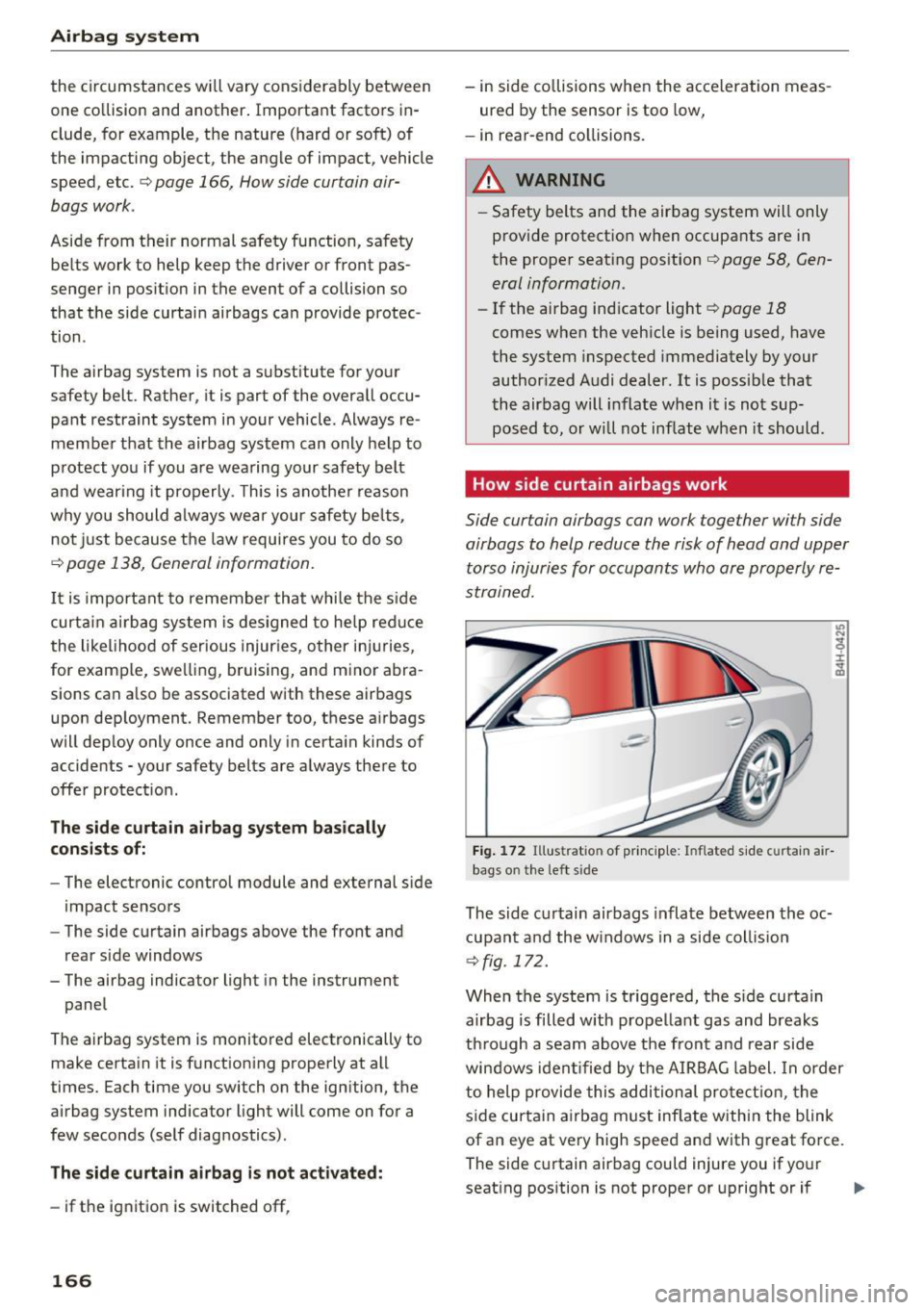
Airbag system
the circumstances will vary considerably between
one collision and another. Important factors in
clude, for example, the nature (hard or soft) of
the impacting object, the angle of impact, vehicle
speed, etc.
c:;, page 166, How side curtain air
bags work .
Aside from their normal safety function, safety
belts work to help keep the driver or front pas
senger in position in the event of a collision so
that the side curtain airbags can provide protec
tion .
The airbag system is not a substitute for your safety belt. Rather, it is part of the overall occu
pant restraint system in your vehicle . Always re
member that the airbag system can only help to
protect you if you a re wearing your safety belt
and wearing it properly . This is another reason
why you should always wear your safety belts,
not just because the law requires you to do so
c:;, page 138, General information.
It is important to remember that whi le the s ide
curtain airbag system is designed to help reduce
the likelihood of serious injuries, other injuries,
for example, swelling, bruising, and minor abra
s ions can a lso be associated with these airbags
upon deployment. Remember too, these a irbags
will deploy only once and only in certa in kinds of
accidents - your safety belts are always there to
offer protect ion .
The side curtain airbag system ba sically
consists of:
-The electronic control module and external side
impact sensors
- The side curtain airbags above the front and
rear side windows
- The airbag indicator light in the instrument
panel
The airbag system is monitored electronically to make certain it is functioning properly at all
times. Each time you switch on the ignition, the
airbag system indicator light will come on for a
few seconds (self diagnostics) .
The side curtain airbag is not activated:
-if the ignition is switched off,
166
- in side collisions when the acceleration meas
ured by the sensor is too low,
- in rear-end collisions.
A WARNING
-Safety belts and the airbag system will only
provide protection when occupants are in
the proper seating position
c:;, page 58, Gen
eral information .
-If the airbag ind icator light c:;, page 18
comes when the vehicle is being used, have
the system inspected immediately by your
author ized Audi dealer. It is possible that
the airbag will inflate when it is not sup
posed to, or wi ll not inflate when it should.
How side curtain airbags work
Side curtain airbags can work together with side
airbags to help reduce the risk of head and upper
torso injuries for occupants who are properly re
strained.
Fig. 172 Illus trat io n of princ iple: I nflated s ide c urtain a ir
bags o n the left side
The side curtain airbags inflate between the oc
cupant and the windows in a side collision
¢ fig. 172.
When the system is triggered, the side curta in
airbag is filled w ith propellant gas and breaks
through a seam above t he front and rear side
windows identified by the AIRBAG label. In order
to help provide this additional protection, the
s ide curtain airbag must inflate within the blink
of an eye at very high speed and with g reat fo rce.
The side curtain airbag could injure you if your
seat ing position is not proper or upright or if
Page 169 of 302
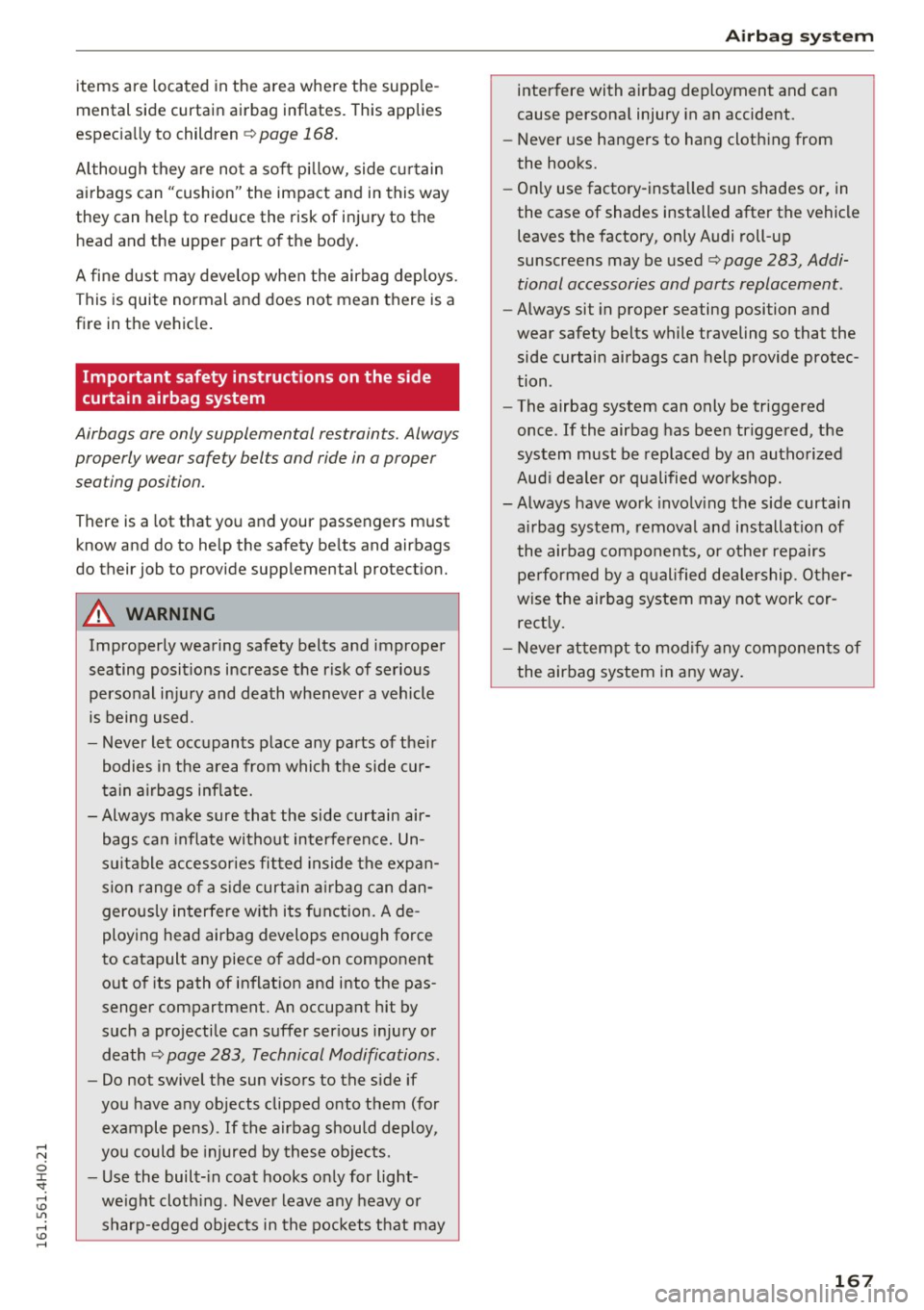
items are located in the area where the supple
mental side curtain airbag inflates. This applies
especially to children¢
page 168.
Although they are not a soft pillow, side curtain
airbags can "cushion" the impact and in this way
they can help to reduce the risk of injury to the
head and the upper part of the body.
A fine dust may develop when the airbag deploys.
This is quite normal and does not mean there is a
fire in the vehicle.
Important safety instructions on the side
curtain airbag system
Airbags are only supplemental restraints. Always
properly wear safety belts and ride in a proper
seating position.
There is a lot that you and your passengers must
know and do to help the safety belts and airbags
do their job to provide supplemental protection.
A WARNING
Improperly wearing safety belts and improper
seating positions increase the risk of serious
personal injury and death whenever a vehicle
is being used.
- Never let occupants place any parts of their
bodies in the area from which the side cur
tain airbags inflate.
-Always make sure that the side curtain air
bags can inflate without interference. Un
suitable accessories fitted inside the expan
sion range of a side curtain airbag can dan gerously interfere with its function. A de
ploying head airbag develops enough force
to catapult any piece of add-on component
out of its path of inflation and into the pas
senger compartment. An occupant hit by
such a projectile can suffer serious injury or
death ¢
page 283, Technical Modifications.
-Do not swivel the sun visors to the side if
you have any objects clipped onto them (for example pens). If the airbag should deploy,
you could be injured by these objects.
- Use the built-in coat hooks only for light
weight clothing . Never leave any heavy or
sharp-edged objects in the pockets that may
Airbag system
interfere with airbag deployment and can
cause personal injury in an accident.
- Never use hangers to hang clothing from
the hooks.
- Only use factory-installed sun shades or, in
the case of shades installed after the vehicle
leaves the factory, only Audi roll-up
sunscreens may be used
c:> page 283, Addi
tional accessories and parts replacement .
-Always sit in proper seating position and
wear safety belts while traveling so that the
side curtain airbags can help provide protec
tion .
- The airbag system can only be triggered
once. If the airbag has been triggered, the
system must be replaced by an authorized
Audi dealer or qualified workshop.
-Always have work involving the side curtain
airbag system, removal and installation of
the airbag components, or other repairs
performed by a qualified dealership . Other
wise the airbag system may not work cor
rectly.
- Never attempt to modify any components of
the airbag system in any way.
167
Page 171 of 302
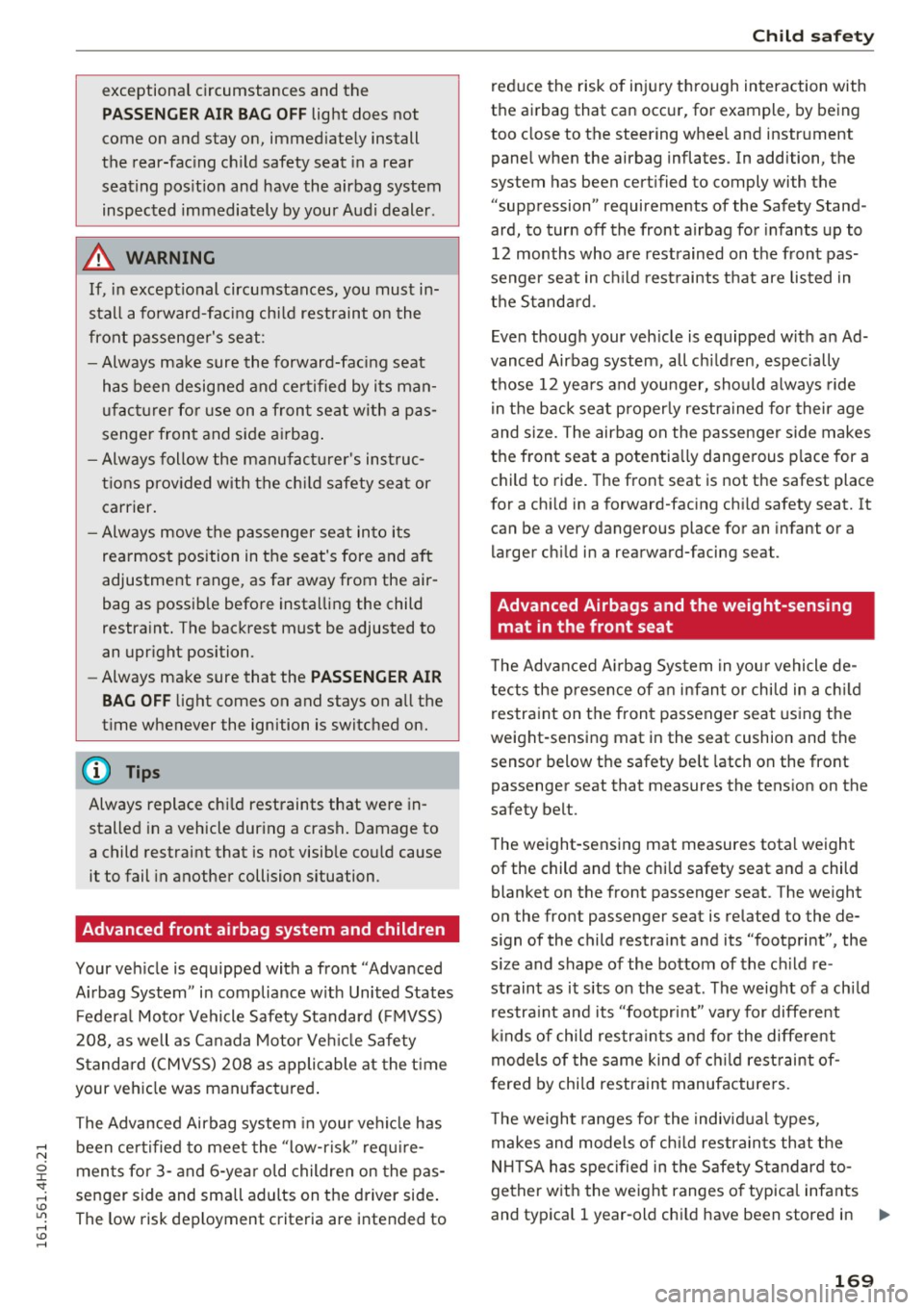
exceptional circumstances and the
PASS ENGER AIR BAG OFF light does not
come on and stay on, immed iately install
the rear-fac ing ch ild safety seat in a rear
seating pos it ion and have the airbag system
inspected immediately by your Audi dealer .
A WARNING
If, in exceptio nal circumstances, you must in
stall a forward-facing chi ld restraint on the
front passenger's seat:
- Always make sure the forward-fac ing seat
has been designed and ce rtified by its man
ufact urer fo r use on a front seat with a pas
senger front and side airbag .
- Always follow the manufact urer's instruc
tions prov ided with the ch ild safety seat or
carrier.
- Always move the passenger seat into its
rearmost position in the seat's fore and aft
adjustment range, as far away from the air
bag as possib le before installing the child
restraint. The backrest must be adjusted to
an upr ight position.
- Always make sure that the
PA SSENGER AIR
BAG OFF
light comes on and stays on all the
t ime whenever the ignition is switched on.
{D) Tips
Always replace chi ld restraints that were in
stalled in a vehicle dur ing a crash . Damage to
a child restraint that is not visible could cause
it to fail in another collision situation.
Advanced front airbag system and children
Your veh icle is equipped with a front "Advanced
Airbag System " in compliance w ith United States
F edera l Moto r Vehicle Safety Standard (FMVSS)
208, as well as Canada Motor Ve hicle Safe ty
Stand ard (CMVSS) 208 as appli cable at the t ime
your vehicle was manufactured .
The Advanced Airbag system in your ve hicle has
been ce rtified to meet the "low-risk " requ ire
ments for 3 -and 6-year old children on the pas
senger side and small adults on the driver side .
The low risk deployment criteria are intended to
Ch ild safety
reduce the risk of injury through interaction with
the airbag that can occur, for example, by being
too close to the steering wheel and instr ument
panel when the airbag inflates. In addition, the
system has been cert ified to comply with the
"suppression" requirements of the Safety Stand
ard, to turn off the front airbag for infants up to
12 months who are restrained on the front pas
senger seat in ch ild rest raints that are lis ted in
the S tanda rd .
Even thoug h your veh icle is equipped with an Ad
vanced Airbag system, all ch ildren, especially
those 12 yea rs and younger, sho uld a lways ride
i n the back seat properly restra ined for their age
and size . The airbag on the passenger side makes
the front seat a potentia lly dangerous p lace for a
child to ride. The front seat is not the safest place
for a ch ild in a forward-fac ing ch ild safety seat. It
can be a very dangerous place for an infant or a
larger ch ild in a rearward-facing seat .
Advanced Airbags and the weight -sensing
mat in the front seat
T he Advanced A irbag System in you r vehicle de
tects the presence of a n in fan t or child in a ch ild
restra int on the front passenger seat using the
weight-sensing mat in the seat cushion and the sensor below the safety belt latch on the front
passenger seat that measures the tension on the
safety belt.
The weight-sensing mat measures total weight
of the child and the chi ld safety seat and a child
blanket on the front passenger seat. The weight
on the front passenger seat is related to the de
s ign of the child restra int and its "footprint" , the
s ize and shape of the bottom of the c hild re
straint as it s its on the seat. The weight of a chi ld
r estra int and its "footprint " va ry for different
k inds of child restra ints and for the different
models of the same kind of ch ild rest raint of
fered by child restraint manufacturers.
T he weight ranges for the individ ual types,
makes and mode ls of chi ld restrain ts that the
N HT SA has spec ified in the Safety Standard to
gether with the weight ranges o f typical infants
and typical 1 year-old chi ld have been stored in .,.
169
Page 173 of 302
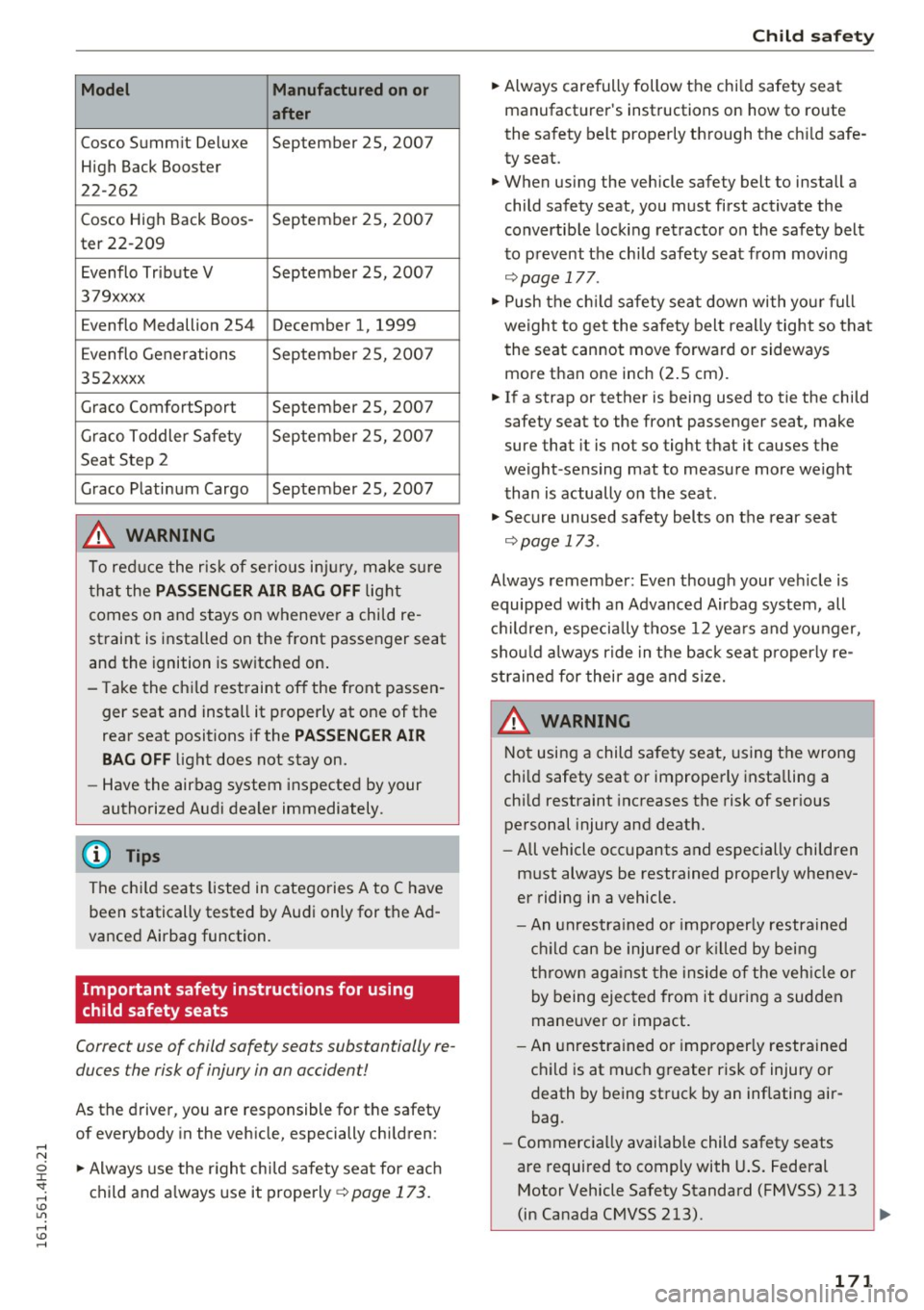
Model Manufactured on or
after
Cosco Summit Deluxe September 25, 2007
High Back Booster
22-262
Cosco High Back Boos -
September 25, 200 7
ter 22-209
Evenflo Tr ibute V September 25, 2007
379xxxx
Evenflo Medallion 254 December 1, 1999
Evenflo Generations September 25, 2007
352xxxx
Graco ComfortSport September 25, 2007
Graco Toddler Safety September 25, 2007
Seat Step 2
Graco Platinum Cargo September 25, 2007
.&, WARNING
To reduce the risk of serious inju ry, make sure
that the
PA SSEN GER AIR BAG OFF light
comes on and stays on whenever a child re
straint is installed on the front passenger seat
and the ignition is switched on.
- Take the child restraint off the front passen
ger seat and install it properly at one of the
rear seat positions if the
P A SSEN GER AIR
BAG OFF
light does not stay on.
- Have the airbag system inspected by your
authorized Audi dealer immediately.
(D Tips
The chi ld seats listed in categories A to C have
been statically tested by Audi only for the Ad
vanced Airbag function.
Important safety instructions for using
child safety seats
Correct use of child safety seats substantially re
duces the risk of injury in an accident!
As the driver, you are responsible for the safety
of everybody in the veh icle, especially children:
.,. Always use the right chi ld safety seat for each
child and a lways use it properly
q page 173.
Child safety
.,. Always carefully follow the chi ld safety seat
manufacturer's instructions on how to route
the safety belt properly through the ch ild safe
ty seat.
.,. When using the vehicle safety belt to install a
child safety seat, you must first activate the
convertible locking retractor on the safety belt
to prevent the chi ld safety seat from moving
q page 177.
.,. Push the ch ild safety sea t down with yo ur full
weight to get the safety belt really tight so that the seat cannot move forward or sideways
more than one inch (2.5 cm).
.,. If a strap or tether is being used to tie the child
safety seat to the front passenger seat, make
sure that it is not so tight that it causes the
weight -sensing mat to measure more weight
than is actually on the seat .
.,. Secure unused safety belts on the rear seat
q page 173.
Always remember: Even though your veh icle is
equipped with an Advanced Airbag system, all
c hi ldren, especia lly t hose 12 yea rs and younger,
sho uld a lways ride in th e back seat p roper ly re·
strained for their age and s ize.
A WARNING
=
Not using a child safety seat, using the wrong
chi ld safety seat or improperly insta lling a
chi ld restraint increases the risk of serious
personal injury and death.
- All vehicle occupants and especially children
must always be restrained properly whenev
er riding in a vehicle.
- An unrestra ined o r improperly restrained
c hi ld can be injured o r killed by being
thrown aga inst the inside of the veh icle or
by being ejected from it during a sudden
maneuver or impact.
- An unrestra ined or improperly restrained
child is at much greater risk of injury or
death by being struck by an inflating air bag.
- Commercially availab le child safety seats
are requi red to comply with U .S. Federal
Motor Vehicle Safety Standard (FMVSS) 213
(in Canada CMVSS 213). ..,_
17 1